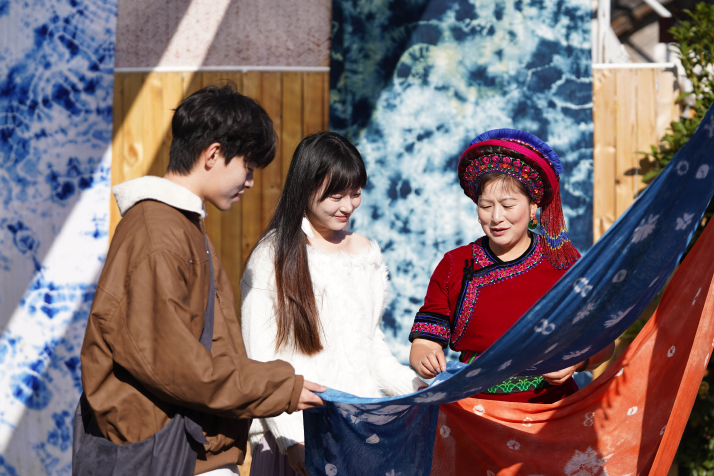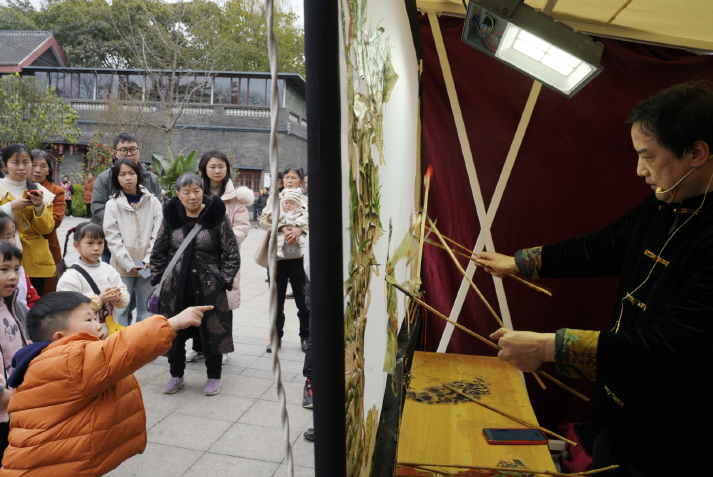
In a calligraphy class at Zhejiang University in Hangzhou, Zhejiang Province, Du Jianghan incorporates historical context into his teaching. Although still a student in the university, he teaches part time at the university’s extracurricular calligraphy program, preserving and promoting calligraphy culture.
Du is an active consumer of intangible cultural heritage (ICH) products. He regularly purchases calligraphy brushes, paper and ink to practice. During his time at Zhejiang University, he also developed an interest in seal carving, another ICH practice that requires specialized materials. “The stones, seal ink and sandpaper required for seal carving are more expensive than the materials I use for calligraphy,” he explained to China Youth Daily (CYD) newspaper.
ICH-derived cultural and creative products, experiential workshops, and ICH-inspired clothing are gaining popularity among young consumers. A recent survey by news portal Xiaoyuan.youth.cn of 1,382 college students nationwide revealed that 74.89 percent of respondents had purchased ICH-related products or services.
Increasing popularity
Beyond calligraphy-related purchases, Du also spends on other ICH products. During a visit to Weifang, Shandong Province, a city renowned as the “world capital of kites” due to its long history of kite making and flying, he bought a small kite to display on his desk. “Some ICH items are rare and expensive, but I’m still willing to spend money on them because I think it’s worth it,” Du said.
Cai Yujie, a student from Chongqing University in Chongqing Municipality, experienced ICH firsthand when she visited the studio of a tie-dye handicraft representative inheritor in Chongqing. Surrounded by a massive dye vat and a colorful display of tie-dye creations, she was immediately captivated. In a single afternoon, and for under 100 yuan ($14), Cai learned the fundamentals of tie-dye and created her own small cloth bag, gaining a valuable hands-on experience with this ICH skill.
Tie-dye involves binding sections of fabric with thread or other materials to create a design before immersing the cloth in dye. The bound areas resist the dye, resulting in a distinctive pattern with dyed and undyed sections interplaying.
“Tie-dye might seem simple at first glance, but it really demands patience,” Cai told CYD. “Creating a lively and uniquely patterned piece of dyed cloth requires a delicate balance of factors, including water quality and precise timing.” The anticipation of revealing the finished product completely absorbed Cai in the artistic process.
Yu Chengyan, a graduate student from Jilin Province studying at Shanxi Normal University in Taiyuan, Shanxi Province, has been living in Shanxi for six years. Each year, during his winter and summer holidays, he brings several bottles of locally produced vinegar back to his hometown. He believes that this ICH product has a unique taste because of its special brewing technique. In addition to traditional vinegar, he also brings related products like hawthorn vinegar and honey vinegar.
Driven by her passion for ICH, Xu Yezhou, a student at Yangzhou University in Jiangsu Province, has amassed a collection of ICH handicrafts. At the Suzhou Museum in Suzhou, Jiangsu, she acquired a Su embroidery silk fan. Su embroidery is one of the four major styles of Chinese silk embroidery, originating from Suzhou and surrounding towns in Jiangsu. During a trip to Jingdezhen, China’s “porcelain capital” in Jiangxi Province, she purchased blue and white porcelain plates (a type of ceramic ware characterized by its white body adorned with intricate designs in cobalt blue pigment) and enamel vases.
The Xiaoyuan.youth.cn survey revealed that among young people who had purchased ICH products or related services, 89.95 percent considered their spending worthwhile. Over 75 percent of respondents were drawn to the cultural significance woven into ICH-related products or services, while 40 percent said they wanted to acquire related knowledge and skills.
Xu embodies this fascination with the cultural value embedded in ICH. She fondly remembers Huishan clay figurines—a traditional craft from her hometown of Wuxi, Jiangsu, typically depicting characters from Chinese folklore and operas—being widely available in local shops during her childhood. During her primary school years, she had the opportunity to create simple clay figurines as part of an experiential course. However, she notes that today, Huishan clay figurines are primarily found in specific tourist locations, their widespread popularity diminished.
Driven by a desire to promote the culture of her hometown, Xu and her classmates now visit local communities in Yangzhou to teach the art of creating Huishan clay figurines, aiming to introduce this ICH skill to a new generation of young people. “These ICH skills, honed over generations, embody the wisdom of the local people and carry a profound cultural heritage,” she told CYD. “They not only provide a source of psychological comfort, allowing people to pray for blessings and express their emotions, but also serve as vehicles for cultural inheritance.”

Trial and error
As ICH elements become increasingly integrated into daily life, the promotion and development of ICH products also face some obstacles. The Xiaoyuan.youth.cn survey revealed that some respondents had never engaged with ICH-related products due to factors such as high prices, a lack of understanding or interest in ICH and limitations in the usability of ICH products.
Dang Feihua, the fifth-generation inheritor of Wang’s Shadow, a family troupe from Xi’an, Shaanxi Province, specializing in shadow puppet making and particularly its intricate carving techniques, echoes this sentiment.
Dang told CYD that the biggest challenge facing ICH products is their lack of practical application in modern life. “Many representative inheritors of ICH are constantly grappling with the question of how to integrate these skills into contemporary society and find relevant uses for them.”
To address this, Dang has established a presence on Douyin, China’s version of TikTok. By combining shadow puppetry with popular video games and animations, such as the popular video game Black Myth: Wukong and the animated blockbuster franchise Ne Zha, he has created captivating shadow puppet adaptations that have garnered nearly 1 million likes on the platform.
“Creative thinking is essential for the successful inheritance and development of ICH,” Dang told CYD. In addition to disseminating shadow puppetry through short videos and art exhibitions, he collaborates with brands like Bingfeng (a local soda brand) and Chahuanong (a milk tea chain), featuring shadow puppet characters on beverage cans and milk tea cups to boost the popularity of shadow puppetry among younger audiences.
Yu expressed his hope that ICH can leverage advanced digital technologies, including virtual reality and augmented reality, to create immersive consumer experiences. “I hope that e-commerce platforms can provide higher-quality displays and improved sales channels for ICH products, and effectively connect these products with specific consumer groups through accurate recommendation algorithms and personalized marketing strategies.”
As a representative inheritor of ICH, Dang is determined to avoid relegating shadow puppetry to the status of a static museum exhibit. In his view, “use” is the most effective form of inheritance. He said, “We must transform ‘what is passed down’ into ‘what is popular.’ Shadow puppetry is a medium for storytelling, and we will create and perform the stories that people want to see.” –The Daily Mail-Beijing Review news exchange item





